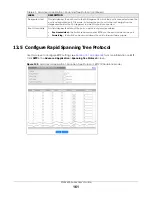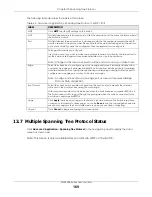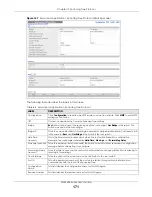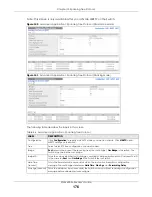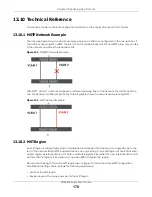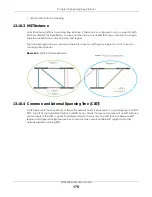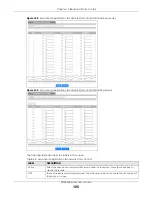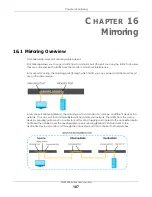
Chapter 13 Spanning Tree Protocol
XGS4600 Series User’s Guide
174
Figure 139
Advanced Application > Spanning Tree Protocol > MRSTP (Stacking Mode)
The following table describes the labels in this screen.
Table 65 Advanced Application > Spanning Tree Protocol > MRSTP
LABEL
DESCRIPTION
Status
Click
Status
to display the
MRSTP Status
screen.
Tree
This is a read only index number of the STP trees.
Active
Select this check box to activate an STP tree. Clear this check box to disable an STP tree.
Note: You must also activate
Multiple Rapid Spanning Tree
in the
Advanced
Application
>
Spanning Tree Protocol
>
Configuration
screen to enable MRSTP
on the Switch.
Bridge Priority
Bridge priority is used in determining the root switch, root port and designated port. The switch
with the highest priority (lowest numeric value) becomes the STP root switch. If all switches
have the same priority, the switch with the lowest MAC address will then become the root
switch. Select a value from the drop-down list box.
The lower the numeric value you assign, the higher the priority for this bridge.
Bridge Priority determines the root bridge, which in turn determines
Hello Time
,
Max Age
and
Forwarding Delay
.
Hello Time
This is the time interval in seconds between BPDU (Bridge Protocol Data Units) configuration
message generations by the root switch. The allowed range is 1 to 10 seconds.
Max Age
This is the maximum time (in seconds) the Switch can wait without receiving a BPDU before
attempting to reconfigure. All Switch ports (except for designated ports) should receive BPDUs
at regular intervals. Any port that ages out STP information (provided in the last BPDU)
becomes the designated port for the attached LAN. If it is a root port, a new root port is
selected from among the Switch ports attached to the network. The allowed range is 6 to 40
seconds.
Содержание XGS4600 Series
Страница 24: ...24 PART I User s Guide ...
Страница 44: ...44 PART II Technical Reference ...
Страница 180: ...Chapter 13 Spanning Tree Protocol XGS4600 Series User s Guide 180 Figure 145 MSTP and Legacy RSTP Network Example ...
Страница 189: ...Chapter 16 Mirroring XGS4600 Series User s Guide 189 Figure 150 Advanced Application Mirroring Standalone Mode ...
Страница 244: ...Chapter 22 Policy Rule XGS4600 Series User s Guide 244 Figure 189 Policy Example EXAMPLE ...
Страница 277: ...Chapter 25 Multicast XGS4600 Series User s Guide 277 Figure 215 Advanced Application Multicast MVR Standalone Mode ...
Страница 559: ...Chapter 59 Access Control XGS4600 Series User s Guide 559 Figure 460 Example Lock Denoting a Secure Connection EXAMPLE ...
Страница 586: ...Chapter 69 Configure Clone XGS4600 Series User s Guide 586 Figure 479 Management Configure Clone Standalone Mode ...
Страница 587: ...Chapter 69 Configure Clone XGS4600 Series User s Guide 587 Figure 480 Management Configure Clone Stacking Mode ...
Страница 594: ...Chapter 71 Port Status XGS4600 Series User s Guide 594 Figure 485 Management Port Status Port Details Standalone Mode ...
Страница 604: ...604 PART III Troubleshooting and Appendices ...


